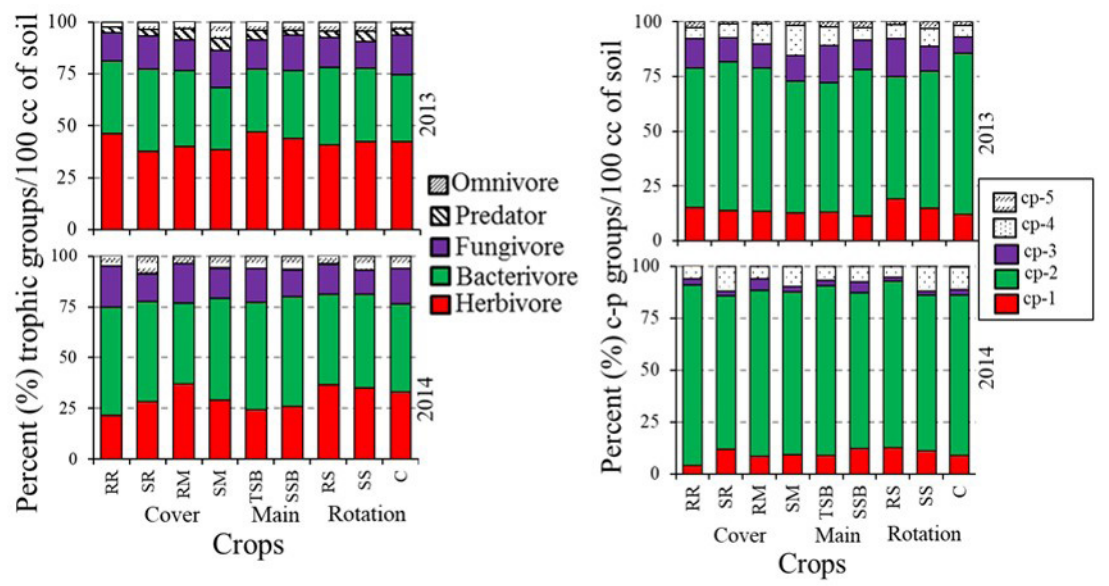
Managing Nematodes, Cover Crops, and Soil Health in Diverse Cropping Systems
DOWNLOADMay 3, 2021 - Haddish Melakeberhan and Stephen Kakaire, MSU Extension
Managing Nematodes, Cover Crops, and Soil Health in Diverse Cropping Systems
Authors: Haddish Melakeberhan and Stephen Kakaire Michigan State University Agricultural Nematology Laboratory, Department of Horticulture
Summary
In recent years, there has been increasing reference to nematodes, soil health, and cover crops in the scientific and popular media. The intertwined nature of these subjects and the mounting science in the literature can sometimes be overwhelming. For example, the science gaps within the subjects and the information scattered mostly across disciplinary lines make it difficult to understand. To give stakeholders some level of integrated information they can use to make informed and integrated decisions, this bulletin summarizes information about soil health, nematodes, and cover crops in three sections. The first section gives an overview of soil health and composition and reproductive strategies of nematodes and the ways they contribute to soil health and nutrient cycling through the soil food web functions. The second section focuses on the effects of good agricultural practices (GAPs) on soil health and nematodes with particular emphasis on tillage and cropping systems, soil amendments, and cover crops. The last section, encompassing half of this bulletin, looks into the future by considering gaps in the science and current soil health and nematode management practices. Specific emphasis is given to a) nematode biology, b) use of cropping systems to exploit weaknesses in the biology of harmful nematodes with proven practices, and c) asking agronomic, economic, and systematic questions before making nematode and soil health management decisions.
1.0. Overview of soil health and role of nematodes:
1.1. What is soil health and where do nematodes fit in? The simplest United States Department of Agriculture (USDA) Natural Resources Conservation Service (NRCS) definition of soil health is “the capacity of a soil to function” (2). Soil health has biological, physiochemical, nutritional, structural, and water-holding components that need to be kept in balance and functioning at all times. When the belowground biological and physiochemical processes are functioning, as an example, they deliver the desirable ecosystem services such as nutrient cycling, regulation of life forms, and crop yield (2, 6, 13, 17, 18, 19, 26, 27, 42, 44). The biological component of soil health has many single- and multi-cellular organisms that are part of the soil food web (SFW). The SFW drives the belowground biological and physiochemical processes that deliver the desirable ecosystem services. Nematodes are small, nonsegmented wormlike organisms present in all ecosystems and a critical part of the SFW (7, 16, 17). An estimated abundance of more than 57 billion nematodes for each human being on the planet (25) and their presence in all ecosystems make nematodes excellent indicators of changes in soil and global ecosystems (7, 45).
1.2. Composition and characteristics of nematodes:
Nematodes are classified into six trophic groups based on their food sources (52). These include bacterivores (bacterial feeders), fungivores (fungal feeders), plant parasites or herbivores (plant feeders), predators (those that feed on nematodes and other life forms), omnivores (those that feed on a range of soil organisms), and animal parasites (those that feed on vertebrates and invertebrates). Examples of what some of the herbivore, bacterivore, fungivore, predator, and omnivore mouth parts look like are shown in Figure 1. Animal parasites are important from the veterinary, medical, and biological control points of view. Herbivores use a stylet, which resembles a hypodermic needle, to pierce roots (root parasites) or leaf tissue (shoot parasites) to obtain nutrition. They are harmful pests that cause crop yield loss. Bacterivores, fungivores, omnivores, and predators are all beneficial and pertinent to nutrient cycling and maintaining healthy soils (13, 19, 32, 35). Herbivorous nematodes exist in the same soil ecosystems as bacterivores, fungivores, omnivores, and predators. Unfortunately, few selective, broadly applicable, and sustainable beneficial and harmful nematode management tools are available to growers.
1.3. Reproductive strategies of nematodes:
All nematodes have life histories and reproductive strategies that fall into five categories commonly known as colonizer-persister (c-p) groups (7, 52). These range from c-p 1, fast reproducing and tolerant to disturbance, to c-p 5, slow reproducing and sensitive to disturbance (7, 17). By analogy, c-p 1 reproduce like mice and c-p 5 like elephants. You can find a complete list of the c-p classification for all of the nematode functional groups at http://nemaplex.ucdavis.edu/ Uppermnus/topmnu.htm#. The c-p groups have different functions. A healthy soil should contain all c-p groups of all beneficial nematodes.
1.4. How do nematodes contribute to soil health?
Not all soil nutrients are available in forms that plants can readily absorb. Nutrients become available as a result of belowground biological and physiochemical processes driven by the SFW (1, 8, 14, 45). As shown in this open-source USDA-NRCS figure, the SFW is like an elaborate soup with ingredients coming from actions of five trophic levels (Figure 2). Level I are the photosynthesizers; Level II, decomposer and parasites; Level III, shredders; Level IV, predators; and Level V, higher level predators. In simple terms, the desired ecosystem services from a functioning SFW are the predator-prey and excretions of many micro- and macro-organisms operating across five trophic levels (27). By feeding on or being food for other organisms, nematodes contribute to nutrient cycling in Levels II, III, and IV of the SFW. As an example, bacterivorous nematodes feeding on bacteria alone excrete nitrogen that meets about 30% of crops’ nitrogen needs (26).
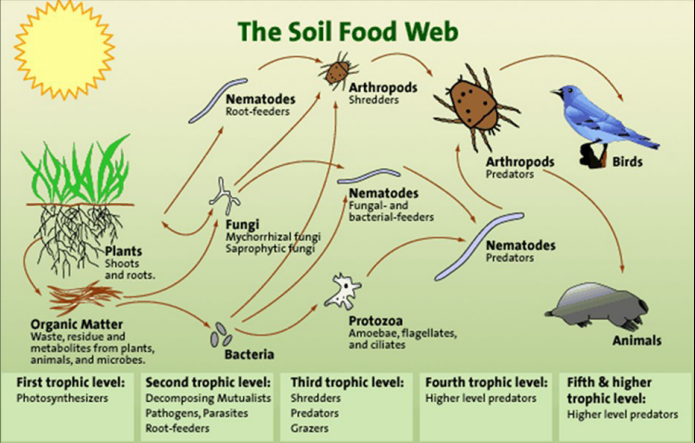
1.5. Translating nematode numbers and functions into practical decision-making:
Knowing that nematodes are key players in the SFW functions and nutrient cycling may be easy to understand. However, converting the numbers and functions into practical application is not. Current management recommendations are based on whether a treatment resulted in an increase or a decrease in beneficial nematodes, harmful nematodes, or both. Unfortunately, no benchmarks exist for how many nematodes and functional groups result in a desired level of soil health. Studies to link nematode numbers and functional guilds—to draw practical applications in Michigan agriculture—are ongoing.
2.0. Effect of good GAPs on soil health and nematodes:
2.1. Role of GAPs in altering soil health conditions: Use of appropriate organic and inorganic forms of nutrient amendments, mulching, tillage, crop rotation, and cover crops are among the most commonly used GAPs to achieve healthy soils in crop production systems (3, 9, 14, 22, 35, 42, 53). Desirable characteristics of healthy soil include improved nutrient cycling, soil structure, and soil environment as well as low harmful nematodes, pests, and disease-causing microbes. While there is a substantial volume of mostly discipline-based knowledge on the characteristics of healthy soil in scientific and popular media, the desirable and undesirable outcomes do not align as expected for a given crop, GAP, and soil type over time (6, 11, 12, 23, 24, 33, 34, 41, 43, 46-51). Under these circumstances, localized knowledge of the effects of GAPs on the desirable and undesirable outcomes is helpful. Examples of the effects of tillage and cropping systems, soil amendments, and cover crops on nematodes and soil health in Michigan agriculture follow.
2.2. Effects of tillage and cropping systems on nematodes and soil health:
Many combinations of tillage and cropping systems have shown variable effects on soil health, beneficial and harmful nematodes, pest and diseases in short- and full-season crops in Michigan and in the U.S. Midwest (11, 20, 21, 33, 42, 43). The effects of tillage and crop rotation on nematodes may be direct or indirect, and soil type is a major influencer. Generally, disturbed soils favor fast-reproducing nematodes more than the slowreproducing kinds because the latter group is slow to recover from disturbance. What is less known is how nematodes, such as the soybean cyst (SCN), a c-p 3 reproductive strategist and a menacing pest of soybeans, respond relative to beneficial nematodes in the same environment. A field study investigated the relationship between an introduced SCN population and the soil nematode community under tillage (chisel plow and no-till) and mono-cropping of either maize (C), SCN-resistant (R), SCN-susceptible (S) soybean, or RCRC or SCSC rotations in a sandy loam soil with a texture of 60.6% sand, 20.5% silt, and 13.2% clay at the Michigan State University (MSU) campus. The study revealed three important points (Figure 3; 11, 33). First, SCN remaining barely detectable six years after it was introduced at damaging levels suggests that there is a lag period between introduction and establishing to reach damaging levels. Second, SCN establishment was less in no-till than in tilled conditions. This suggests that no-till could be a tool that contributes toward keeping SCN population density low. Third, the conditions that favored SCN also favored fast reproducing bacterial-feeding nematodes (11), which are central to nutrient cycling and nitrogen availability to plants. This suggests that many changes in soil biology as a function of GAPs need to be elucidated in order to develop SCN and beneficial nematode management strategies in the same environment.
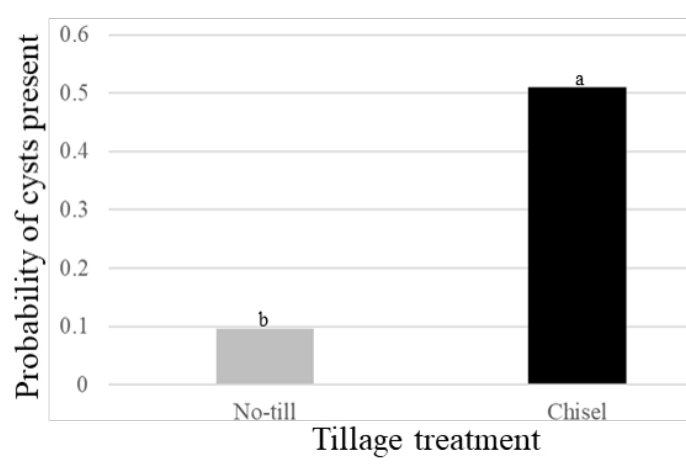
2.3. Effect of soil amendments on nematodes and soil health:
Soil amendments include composted animal manure and plant litter (23), mulching (35), green manure (36, 37, 38), synthetic fertilizers (9, 29), and many combinations. While outcomes vary by location, soil type, crop and form of amendment, benefits of increasing soil organic matter, nutrient cycling, and beneficial nematodes, microbial biomass, and crop quality and yield have been demonstrated (6, 9, 17, 13, 19, 23, 29, 30, 51, 53). Many factors contribute to variable outcomes; two of them are soil amendment and time. The amount of soil amendment needed to supply the nutrient levels for optimal soil health for a soil type and crop is unknown, and the nutrients are not available from the time of application. This is particularly important for compost and green manure amendments because it will take time for the materials to break down and release nutrients or pest regulating compounds. The process of getting the nutrients released, in turn, is dependent on temperature, soil biology, and soil type. The second factor is the time it takes to get consistent and improved soil health outcomes from applying the soil amendments. For example, it took three years of repeated application of animal- and plant-based compost in carrot production on the same location to improve soil health in a Colwood-Brookston sandy clay loam soil with texture of 54% sand, 25% silt, and 21% clay (23). This may not be practical under current practices, but points to the challenges of achieving healthy soils in cropping systems.
2.4. Effects of cover crops and cropping systems on nematodes and soil health:
Much ongoing and past research and publicity covers this topic with still more questions than answers on the impact of cover crops on nematodes, soil health, or both (3, 10, 14, 15, 21, 22, 24, 28, 32, 33, 34, 43, 44. 46-49). MSU hosts the U.S. Midwest Cover Crops Council website (http://mccc.msu.edu/covercroptool/covercroptool. php; 28). Cereals, legumes, and brassicas are the most commonly used cover crops in the U.S. Midwest. Cereals include barley, oats, triticale, and wheat planted either as a winter or spring crop, annual rye grass, cereal rye, pearl millet, and sorghum-sudangrass. Legumes include alfalfa, clover species (Berseem, Crimson, Red, and Sweet), hairy vetch, and sunn hemp. The brassicas include oil seed radish, mustard, rapeseed/canola, kale, turnip, field pennycress, and winter camelina. There are many varieties of these cereals, legumes, and brassicas with varying properties and responses to pests and diseases in different localities. A list of crops and ways they can be used to develop site-specific management practices relative to harmful nematodes is provided at the end of Section 3.0 (Table 3). When considering cropping system-based nematode and soil health management strategies, growers will face two major challenges.
The first challenge is that beneficial and harmful nematodes exist in the same environment and many of the cover and rotation crops are suitable hosts to many plant-parasitic or harmful nematodes. For example, Grabau et al. (2017) (21) tested the effects of 1) fallow control, 2) oats, 3) oilseed radish cv. Defender, 4) a mixture of oats and ‘Defender’ radish, and 5) oilseed rape cv. Dwarf Essex on the nematode community in Michigan carrot production in Grattan Sand (94% sand, 1% silt, 5% clay) soil. The study showed that bacterivorous nematodes increased in carrot season following oats or radish cover crops compared to the control. Unfortunately, population densities of rootlesion nematode were increased by Defender radish compared to other cover crops or fallow control during cover-crop growth and carrot production. This presents growers with making careful tradeoff decisions in their cropping system management.
The second challenge is that successful use of cropping systems for nematode and soil health management depends on knowing what and how each of the cover-, rotation- or main-crops changes in the nematode community structure. Depending on the farming system in question, a main crop could be a cereal, vegetable, legume, or root crop. Any of these crops could be a rotation crop. Independent of whether a crop is used as a cover, rotation, or main crop, it has a footprint on the soil that needs to be standardized for a given location. Figure 4 shows a 2-year study of how oilseed radish and mustard, soybean, corn, and sugar beet varieties affected soil nematode trophic (left side) and c-p groups (right side) in a sandy clay loam sugar beet field in the Saginaw Valley (32). While none of the crops significantly altered the population dynamics of the trophic (left side) or c-p (right side) groups, the proportions had similar variations to what is reported in the literature. Moreover, the study highlighted four points (32):
- Herbivore (harmful) nematodes were about 20% to 30% of the population and root-lesion was the most dominant genus present.
- Omnivores and predators, generally slowreproducing kinds, are present in very low numbers.
- The majority of nematodes present are c-p 2 group, the fast-reproducing types.
- Collectively, these results mean that the soil system is disturbed and stressed, and provide basis for how future studies may improve soil health using cropping systems.
-
Figure 4. Composition of herbivore, bacterivore, fungivore, predator, and omnivore nematodes (left side) composition of c-p groups 1 to 5 of the trophic groups (right side) under cover crops (oilseed radish and mustard), main crop (sugar beet), and rotation crops (soybean and corn [C]) grown in the same sandy clay loam field in 2013 and 2014 growing seasons. The cover crops were sugar beet nematode (SBCN) resistant (RR) and susceptible (SR) oilseed radish and resistant (RM) and susceptible (SM) mustard. The sugar beets were SBCN tolerant (TSB) and susceptible (SSB) and the soybean cyst nematode resistant (RS) and susceptible (SS). (Modified from Melakeberhan, et al., 2018, [32]).
3.0. Future challenges and opportunities for integrated nematode and soil health management:
3.1. We need a paradigm shift:
Achieving sustainable nematode and soil health in cropping systems is a moving target. There needs to be a recognition of key hard facts to make necessary adjustments. First, aligning desirable and undesirable ecosystem services to achieve and sustain optimal soil health conditions in a production system remains difficult, in part, due to gaps in the science and the lack of interdisciplinary integration. Second, the complex relationships among crops, cropping systems, and beneficial and harmful nematodes make soil health management decisions difficult in several ways. For example, harmful and beneficial nematodes live in the same soil environment, few selective control measures exist, and little data is published that show an ideal ratio of beneficial nematodes and harmful nematodes that equal a desirable soil health outcome. Another challenge is that practicing cropping systems is important for soil health, but most harmful nematodes have a broad host range of cover, rotation, and main crops as well as weeds. Under these circumstances, soil health management decisions are likely to be location specific and need to consider multiple factors simultaneously. Third, in order to develop a soil health management strategy that addresses the challenges and fits the local production system conditions, an integrated consideration of all of the cover, rotation, and main crops in use and their status against harmful nematodes will be needed. However, the large volume of discipline-based and highly variable information on nematodes and cropping systems is spread across many publications and is difficult to integrate even for scientists. The following subsections summarize how to consider and exploit the biology of nematodes (Sections 3.2–3.7) and the types of systematic questions that a grower needs to ask (Section 3.8) before developing a soil health management plan that accounts for harmful nematodes and cropping systems to solve location-specific problems (Section 3.9). With this approach, growers will have the power to make integrated and potentially sustainable nematode and soil health management decisions suitable to their production systems.
3.2. Consider expanded nematode sampling frequency:
Management decisions are based on the numbers of nematodes, which vary by soil types, land use practices, agricultural inputs (fertilizers, pesticides, etc., 29), and growing season. In the absence of peer-reviewed analyses of nematodes across time in Michigan agricultural ecosystems and soil types, Figure 5 provides a snapshot of abundance and proportions of beneficial and harmful nematodes in some of the common soils found in Michigan. These results are from 62 soil samples collected within a month in 2013 in urban, field crop, and vegetable soils, and in well-maintained soils under till and no-till and corn soy bean rotations for over 10 years. The differences within and among soil types and cropping systems are an example of how variable nematode abundance could be and that complicates nematode-based soil health management recommendations. One size does not fit all. Because nematodes reproduce at different rates and have multiple generations during a growing season, their population densities are likely to have peaks and valleys. In this case, management decisions based on one sampling time may not be capturing the reality in the field, that is, samples collected at the peaks and valleys will skew recommendations and management decisions. To minimize such events, have at least three sampling points during a growing season that correspond with seedling, reproductive, and harvest stages of the crops. Consult your local extension educators and consultants for a sampling plan and the location to send samples to be analyzed. Find instructions to submit samples to MSU Plant & Pest Diagnostics and associated charges at this website: https://www.canr.msu.edu/pestid/submitsamples/.
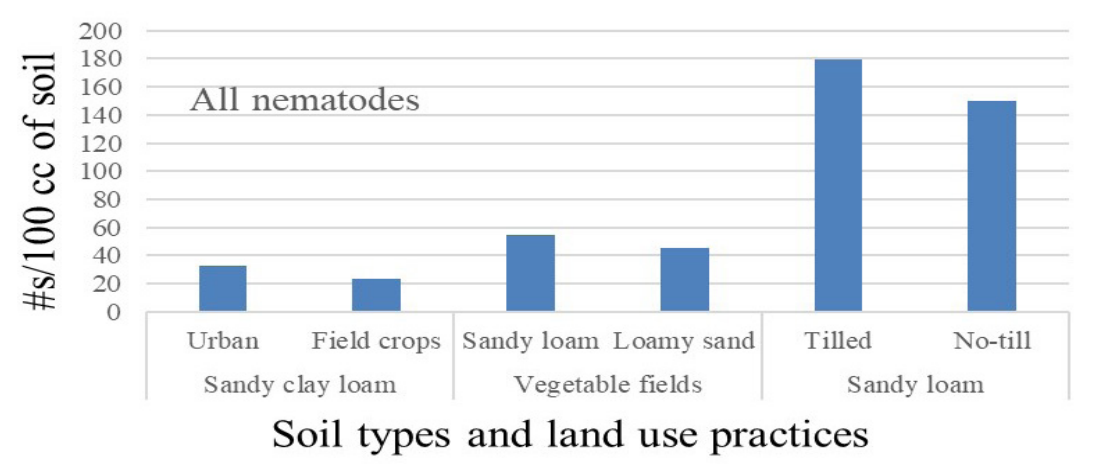
3.3. Know your nematode host range terminology:
Broadly speaking, crops are either resistant (R), tolerant (T), susceptible (S), or immune to nematodes. In a nematode-resistant crop, only a limited number of nematodes invade and grow, and cause no or little yield loss. The difference between nematodesusceptible and -tolerant cultivars is that the latter do not suffer crop yield loss as much as the former. Otherwise, nematode reproduction is high in both. Immune means no nematodes invade, but such crops lack other good agronomic qualities. A crop can also be a trap if it does not allow the harmful nematode to complete a life cycle (31). Any susceptible plant can be used as a trap crop for certain nematodes if it is terminated before the nematode completes a life cycle (see Section 3.6).
3.4. Know what harmful nematodes are in your fields:
Knowing what nematodes are in your field is as important as knowing which crops the nematodes feed on. Depending on the crop, many herbivorous nematodes are commonly known to be present and some at damaging levels in Michigan and U.S. Midwest agriculture (4, 5, 28, 39, 40, 41, 50). These include Dagger (DN), Needle (NN), Stubby root (SRN), Spiral (SPN), Sheath (SHN), Stem and foliar (STFN), Pin (PN), Stunt (STN), Root-lesion (RLN), Northern root-knot (NRKN), False root-knot nematode (FRKN), Carrot cyst (CCN), Clover cyst (CLCN), Hop cyst (HCN), soybean cyst (SCN), and sugar beet cyst (SBCN) nematodes (Table 1). Find out which of these nematodes are present in your field(s).
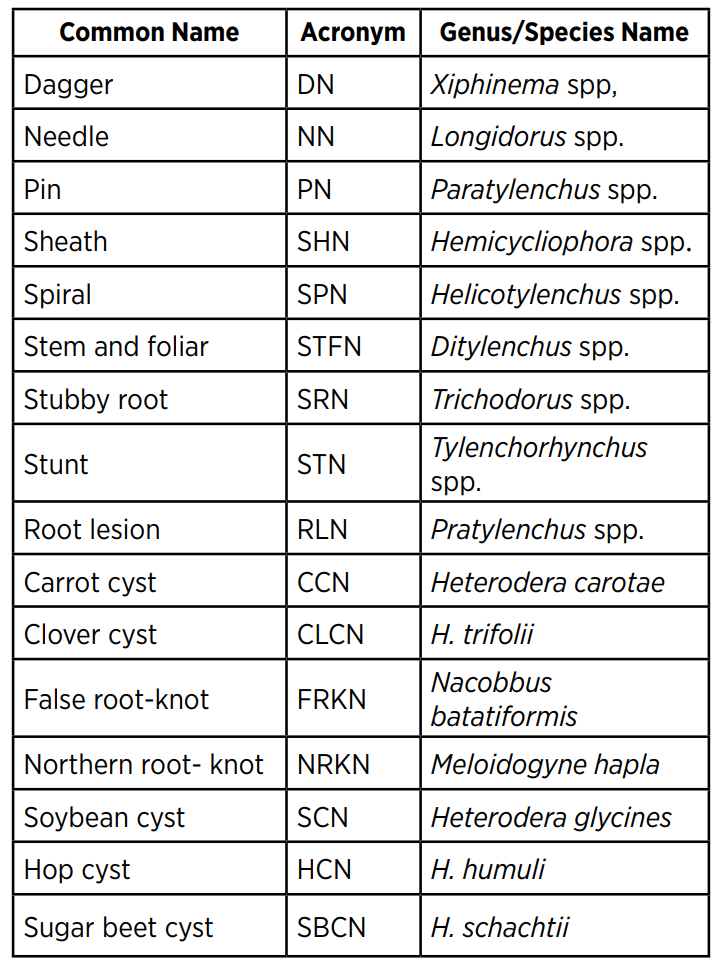 Table 1. Harmful Nematodes Present in Michigan and the U.S. Midwest.
Table 1. Harmful Nematodes Present in Michigan and the U.S. Midwest.3.5. Know the biology of the harmful nematodes in your fields:
Depending on the way these nematodes enter their host plant root or tissue, they can be classified as either ecto-parasites, migratory endoparasites, or sedentary endo-parasites (Table 2). Ecto-parasites feed by inserting their stylet into a root, remaining mobile, and laying their eggs in the soil. Migratory endo-parasites enter host tissue at all infective stages, move through cortical (roots) or parenchyma (leaves and stems) tissue, and lay eggs inside or outside the host. Sedentary endo-parasites have an infective-stage, usually the second-stage juvenile, that enters the host, and establishes a suitable feeding site by modifying plant cells. Then the host supplies these nematodes with enhanced nutrition. All of the feeding behaviors weaken or destroy normal host cell functions of water and nutrient transport, thereby limiting the host’s photosynthetic capacity and crop yield. In addition, sedentary endo-parasites derive their nutrition directly from the plant vascular tissue by ingesting photosynthate, important for plant growth and crop yield.
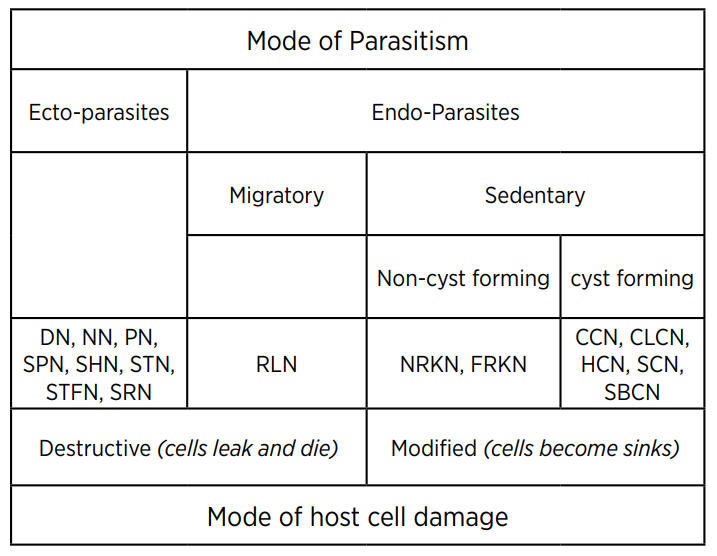
3.6. Exploit the harmful nematodes’ mode of host cell destruction against them:
Ecto- and migratory endo-parasites are capable of moving to new roots if the root on which they are feeding dies (Table 2). Management strategies that are likely to get best outcomes against ecto- and migratory endo-parasites are those that reduce the population density of all life stages of the nematode in question. Sedentary endo-parasites are sitting ducks that cannot migrate once they successfully establish a feeding site. If the root on which they are feeding dies, they die as well. Disrupting their life cycle before they reach adulthood and produce eggs is the weak link that management strategies should focus on. (See green-shaded part of Table 3.) Use of trap cropping is an example.
3.7. Know what beneficial nematodes are in your fields:
: A healthy soil needs to have bacterivore, fungivore, predator, and omnivore nematodes (7, 16). The proportion of the harmful nematodes should be as low as possible compared to the beneficial kinds (Figure 6). If all of the beneficial nematode trophic groups are not present in your soils, you will know that the system is out of balance and it will be difficult to develop a sustainable soil health. Thus far, few published examples demonstrate where specific beneficial nematodes have been introduced to establish in new locations and to improve soil health in an agricultural system.
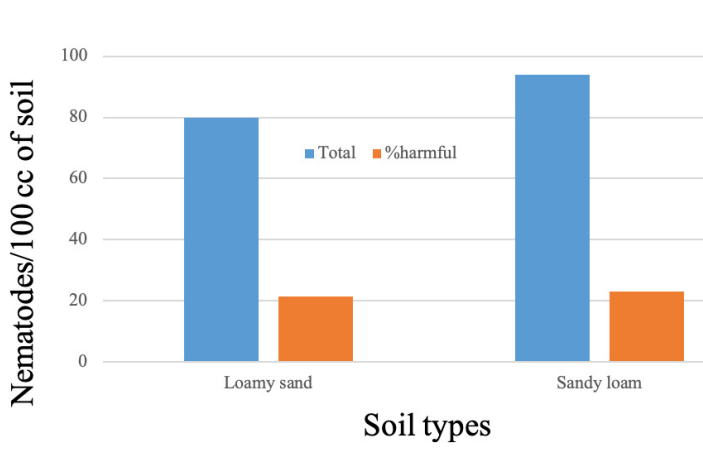
3.8. Ask systematic questions before making decisions about nematode and soil health management:
Management decisions are as good as the breadth, depth, and integrated impact of the information that they are based on. Nematodes may be the primary focus, but they are unlikely to be the only problem in a given soil. Also, know that all of the GAPs have direct or indirect impact on nematodes. Therefore, asking sets of hard questions before developing a plan of action is important.
The first set of questions relate to production practices. These questions are designed to help balancing agronomic benefits and effects on nematodes.
- What are your main crops (Table 3) and their impact on the soil? For example, cereals (nitrogen scavengers), legumes (nitrogen enrichers), root crops (varying impact on soil structure), and others.
- What is your rotation system?
- What are the cover crops that you use?
- How long do the cover crops stay on the ground?
- What are your weed management practices? Many weeds are hosts to harmful nematodes.
- What are your tillage practices? Among other things, tillage affects all nematodes and not always in desirable ways.
- What is your soil fertility management practice? Soil amendments affect nematodes (9, 23).
The second set of questions relate to harmful nematodes.
- Based on sampling (Section 3.2), what harmful nematodes do you have (Table 1)?
- Are your main, cover, or rotation crops host to harmful nematodes (Table 3)? The chances are that they are suitable hosts to one or more harmful nematodes because of the lack of broad-spectrum nematoderesistant crops.
- Are population densities of the harmful nematodes considered low, medium, or high? There is little peerreviewed science that shows a known number of nematodes result in a known percent yield loss in a given soil type or production practice.
The third set of questions relate to beneficial nematodes. Is the priority to manage beneficial nematodes, harmful nematodes, or both? The simple answer is both because they co-exist in the same environment. This means developing a location-specific management strategy will require carefully weighing the purpose of using cover and rotation crops, the biology of the harmful nematodes (Table 2), and the host suitability database (Table 3). Then look for combinations that increase the total numbers of bacterivore, fungivore, predator, and omnivores. An outcome that resembles Figure 4 is an indication that something is out of balance in that system.
The fourth set of questions relate to affordability. What can you afford to do now or across a planned period? In the end, it comes down to economics. The fifth set of questions relate to your management and decision-making.
What is your management philosophy? Answering this set of questions will help growers evaluate whether or not they were applying information purely on a disciplinary basis or in integrated ways. This, in turn, will lead to making necessary adjustments to apply an integrated approach so that multiple limiting factors can be addressed simultaneously and more efficiently.
3.9. Develop a nematode and soil health management plan that fits your cropping system:
With the knowledge of the types and biology of the nematodes (Sections 3.2, 3.4, 3.5, and 3.7); crops and cropping systems (Section 2.4); the crops’ R, S, or T status against the harmful nematodes (Section 3.3.); and answers to the systematic questions (Section 3.8); a grower will have enough information to develop an integrated nematode, cover crop, and soil health management plan. As part of developing an integrated and location-specific nematode and soil health management plan using proven practices of trap-, rotation-, and covercropping systems, growers can use Table 3 as a template to make decisions.
What Table 3 contains: Table 3 provides a partial list of the major crops and harmful nematodes present in the U.S. Midwest (4, 5, 10, 20, 28, 39, 41, 50). The crops’ common and scientific names are listed in groups of cereals, legumes, root crops, brassicas. and vegetables. Many of these crops have varieties with different traits and status against harmful nematodes. The nematodes are listed by acronym as described in Table 1 and further divided into mobile or ectoand migratory endo-parasites (those that move inside or outside host tissue) and sedentary (green shade, those that don’t move after establishing a feeding site) as described in Table 2. Like many of the crops, nematodes such as SCN have populations with varying appetites to varieties of soybeans.
How to use Table 3: You know what crops and cropping systems you practice or plan to (Table 3, http://mccc.msu. edu/covercroptool/covercroptool.php). From doing a survey (Section 3.2), you will know what harmful nematodes are in your fields (Table 1). From the information in the websites listed at the bottom of Table 3 and internet search, you will get the status of your crops to the harmful nematodes that are in your fields. Depending on the grower, compiling this information may require input from expertise at MSU and MSU Extension’s statewide educator network or elsewhere as needed. Finally, fill out the R, S, or T status of your crops relative to the harmful nematodes present in your fields. The information that goes into Table 3 is likely to change frequently depending on peer-reviewed and popular publications. Up-to-date information about crops, nematodes, and crop suitability to harmful nematodes can be accessed in the websites listed at the bottom of Table 3. While you can search the internet for nematodes and crops, the information may not be as organized as in the listed websites.
How to make decisions based on the information on Table 3: Depending on the R, S, or T combinations across the crops and harmful nematodes, you will likely have many options where targeted trap-, rotation- or cover-crop systems to manage nematodes and soil health can be applied. If nematodes in the green-shaded columns are present, for example, you know that a carefully timed trap cropping will be an option (Section 3.6). Destroying and incorporating the plants into the soil before the nematodes complete a life cycle will add organic matter that will also benefit the good nematodes and soil health. Another example is scaling up management decisions across locations. Depending on the enterprise, a grower could have farms across counties with the same or different problems. This approach allows for scaling up on the basis of similarities of location-specific problems rather than one-size-fits-all and with little regard to differences among locations. As growers make a habit of keeping these records year after year and realize the advantages from the level of integration presented herein, they will likely identify other factors that may be incorporated into their soil health management strategies.
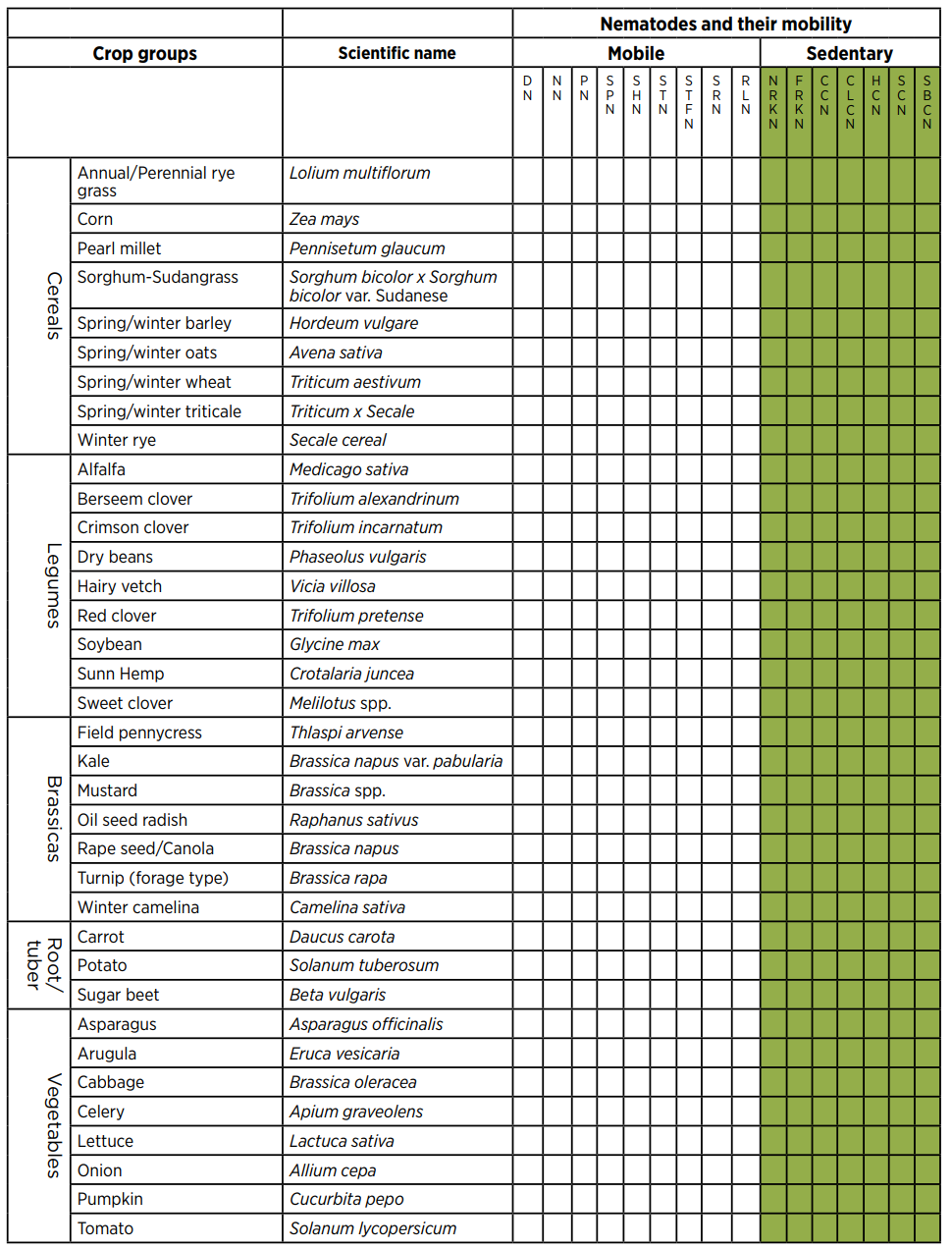
Acronyms are as shown in Table 1 and nematodes are grouped as mobile (those that move if host cell dies) and sedentary (those that will die if host cell dies, Table 2). Green-shaded nematodes are those where trap cropping will be most effective. You can access up-to-date information on nematodes and crops on the following websites:
Midwest Cover Crops Council Cover Crop Decision Tool: http://mccc.msu.edu/covercroptool/covercroptool.php;
MSU Extension Cover Crops: https://www.canr.msu.edu/ cover_crops/species/;
University of California–Davis Nemaplex Index to Common Names: http://nemaplex.ucdavis.edu/IndexFiles/ common%20names.html;
University of Minnesota Extension Cover Crops: https:// extension.umn.edu/soil-and-water/cover-crops.
References:
- Anonymous. (2001). Agricultural management effects on earthworm populations. USDA/NRCS Soil Quality-Agronomy Technical Note No. 11.
- Anonymous. (2016). Soil health. NRCS. http://www. nrcs.usda.gov/wps/portal/nrcs/main/soils/health/.
- Beehler, J., Fry, J., Negassa, W., & Kravchenko, A. K. (2017). Impact of cover crops on soil carbon accrual in topographically diverse terrain. Journal of Soil and Water Conservation, 72, 272-279.
- Berney, M. F., & Bird, G. W. (1992). Distribution of Heterodera carotae and Meloidogyne hapla in Michigan carrot production. Annals of Applied Nematology, 24, 776-778.
- Bird, G. W., & Warner, F. (2018). Nematodes and nematologists of Michigan. In S. A. Subbotin & J. J. Chitambar (Eds.), Plant parasitic nematodes in sustainable agriculture of North America. Sustainability in plant and crop protection, pp. 57–85. https://doi. org/10.1007/978-3-319-99588-5_3.
- Blanc, C., Sy, M., Djigal, D., Brauman, A., Normand, P., & Villenave, C. (2006). Nutrition on bacteria by bacterial-feeding nematodes and consequences on the structure of soil microbial community. European Journal of Soil Biology, 42, S70S78.
- Bongers, T., & Ferris, H. (1999). Nematode community structure as a bioindicator in environmental monitoring. Trends in Ecology and Evolution, 14, 224–228.
- Bongers, T., Van der Meulen, H., & Korthals, G. (1997). Inverse relationship between the nematode community maturity index and plant parasite index under enriched nutrient conditions. Applied Soil Ecology, 6, 195–199.
- Bulluck, L. R. III, Barker, K. R., & Ristaino, J. B. (2002). Influences of organic and synthetic soil fertility amendments on nematode trophic groups and community dynamics under tomatoes. Applied Soil Ecology, 21, 233–250.
- Chen, S., Wyse, D. L., Johnson, G. A., Porter, P. M., Stetina, S. R., Miller, D. R., Betts, K. J., Klossner, L. D., & Haar, M. J. (2006). Effect of cover crops alfalfa, red clover, and perennial ryegrass on soybean cyst nematode population and soybean and corn yields in Minnesota. Crop Science, 46, 1890–1897.
- Cheng, Z., Melakeberhan, H., Mennan, S., & Grewal, P. S. (2018). Relationship between soybean cyst nematode, Heterodera glycines, and soil nematode communities under long-term tillage and crop rotation systems. Nematropica, 48, 101–115.
- Collins, H. P., Alva, A., Bydston, R. A., Cochran, R. L., Hamm, P. B., McGuire, A., & Riga, E. (2006). Soil microbial, fungal, and nematode responses to soil fumigation and cover crops under potato production. Biology and Soil Fertility, 42, 247–257.
- Doran, J. W., & Zeiss, M. R. (2000). Soil health and sustainability: Managing the biotic component of soil quality. Applied Soil Ecology, 15, 3–11.
- DuPont, S. T., Ferris, H., & Van Horn, M. (2009). Effects of cover crop quality and quantity on nematode-based soil food webs and nutrient cycling. Applied Soil Ecology, 41, 157–167.
- Fageria, N., Baligar, V., & Bailey, B. (2005). Role of cover crops in improving soil and row crop productivity. Communications in Soil Science and Plant Analysis, 36, 2733–2757.
- Ferris, H., Bongers, T., & De Goede, R. G. M. (2001). A framework for soil food web diagnostics: Extension of the nematode faunal analysis concept. Applied Soil Ecology, 18, 13–29.
- Ferris, H., Venette, R. C., & Scow, K. M. (2004). Soil management to enhance bacterivore and fungivore nematode populations and their nitrogen mineralization function. Applied Soil Ecology, 24, 19-35.
- Fine, A. K., van Es, H. M., & Schindelbeck, R. R. (2017). Statistics, scoring functions, and regional analysis of a comprehensive soil health database. Soil Science Society of America Journal, 81, 589. https://doi.org/10.2136/sssaj2016.09.0286.
- Gebremikael, M. T., Steel, H., Bert, W., Maenhout, P., Sleutel, S., & De Neve, S. (2015). Quantifying the contribution of entire free-living nematode communities to carbon mineralization under contrasting C and N availability. PLOS ONE | DOI:10.1371/journal. pone.0136244.
- Grabau, Z. J., & Chen, S. (2016). Influence of longterm corn-soybean crop sequences on soil ecology as indicated by the nematode community. Applied Soil Ecology, 100, 172–185.
- Grabau, Z. J., Maung, Z. T. Z., Noyes, C., Baas, D., Werling, B. P., Brainard, D. C., & Melakeberhan, H. (2017). Effects of cover crops on Pratylenchus penetrans and the nematode community in carrot production. Journal of Nematology, 49, 114–123.
- Gruver, L. S., Weil, R. R., Zasada, I. A., Sardanelli, S., & Momen, B. (2010). Brassicaceous and rye cover crops altered free-living soil nematode community composition. Applied Soil Ecology, 45, 1–12.
- Habteweld, A. W., Brainard, D., Kravchenko, A., Grewal, P. S., & Melakeberhan, H. (2018). Effects of plant and animal waste-based compost amendments on the soil food web, soil properties, and yield and quality of fresh market and processing carrot cultivars. Nematology, 20, 147–168.
- Hinds, J., Wang, K. H., Marahatta, S. P., Meyer, S. L. F., & Hooks, C. R. R. (2013). Investigating the influence of sunn hemp cover cropping and organic fertilizer on the nematode community in a zucchini cropping system. Journal of Nematology, 45, 265-271.
- Hollingshead, T. (2019). There are 57 billion nematodes for every human on earth: Understanding them will help address climate change. https://news. byu.edu/there-are-57-billion-tiny-wormlike-nematodes-for-every-human-on-earth-now-we-knowwhere-most-of-them-live.
- Ingham E. R. (1996). The soil food web: Its importance in ecosystem health. https://www.soilfoodweb. com/publications/.
- Ingham, E. R. (2019). Soil biology and the landscape. USDA/NRCS. https://www.nrcs.usda.gov/wps/ portal/nrcs/detailfull/soils/health/biology/?cid=nrcs142p2_053868.
- Midwest Cover Crops Council and Purdue Diagnostic Training and Research Center. (2014). Midwest cover crops field guide (2nd ed.). www.mccc.msu.edu/.
- . Melakeberhan, H., & Avendaño, M. F. (2008). Spatio-temporal consideration of soil conditions and site-specific management of nematodes. Precision Agriculture, 9, 341–354.
- Melakeberhan, H. (2007). Effect of starter nitrogen on soybeans under Heterodera glycines infestation. Plant and Soil, 301, 111–121.
- Melakeberhan, H., Kravchenko, A., Dahl, J., & Warncke, D. (2009). Effects of soil types and Meloidogyne hapla on the multi-purpose uses of arugula (Eruca sativa). Nematology, 12, 115–120.
- Melakeberhan, H., Maung, Z. T. Z., Lee, C.-L., Poindexter, S., & Stewart, J. (2018). Soil type-driven variable effects on cover- and rotation-crops, nematodes and soil food web in sugar beet fields reveal a roadmap for developing healthy soils. European Journal of Soil Biology, 85, 53–63.
- . Melakeberhan, H., Wang, W., Kravchenko, A., & Thelen, K. (2015). Effects of agronomic practices on the timeline of Heterodera glycines establishment in a new location. Nematology, 17, 705–713. DOI: 10.1163/15685411-00002903.
- Myers, R. (2019). 10 ways cover crops enhance soil health. Sustainable Agriculture Research and Education. https://www.sare.org/Learning-Center/ Topic-Rooms/Cover-Crops/Ecosystem-Servicesfrom-Cover-Crops/10-Ways-Cover-Crops-EnhanceSoil-Health?utm_source=email+marketing+Mailigen&utm_campaign=Free+Download%3A+Cover+Crop+Ecosystem+Services&utm_medium=email.
- Quintanilla, M., Wang, K. H., Tavares, J., & Hooks, C. R. (2016). Effects of mulching on above and below ground pests and beneficials in a green onion agroecosystem. Agriculture, Ecosystems & Environment, 224, 75–85.
- Riga, E., & Collins, H. (2005). The effect of green manures on Meloidogyne chitwoodi and Paratrichodorus allius, economically important nematodes of potatoes in the Pacific Northwest of USA. Agroindustrial, 3, 321–322.
- Riga, E. (2011). The effect of Brassica green manures on plant parasitic and free-living nematodes used in combination with reduced rates of synthetic nematicides. Journal of Nematology, 43, 119–121.
- Riga, E., Mojtahedi, H., Ingham, R. E., & McGuire, A. M. (2003). Green manure amendments and management of root-knot nematodes on potato in the Pacific Northwest of USA. Nematology Monographs and Perspectives, 2, 151–158.
- Schnabelrauch, L., Bird, G. W., Laemmlen, F. F., & Sink, K. C. (1981). Occurrence, symptomatology and control of Ditylenchus dipsaci associated with commercial production of Phlox subulata. Plant Disease, 65, 745–748.
- Schutter, M. E., Sandeno, J. M., & Dick, R. P. (2001). Seasonal, soil type, and alternative management influences on microbial communities of vegetable cropping systems. Biology and Fertility of Soils, 34, 397–410.
- Smiley, R. W., Yan, G. P., & Gourlie, J. A. (2014). Selected Pacific Northwest crops as hosts of Pratylenchus neglectus and P. thornei. Plant Disease, 98, 1341–1348.
- Snapp, S., Tiemann, L., Rosenzweig, N., Brainard, D., & Bird, G. (2016). Managing soil health for root and tuber crops (E-3343). Michigan State University Extension.
- Spiegel, B., Vollsedt, M., & Gullickson, G. (2019). Soil health digest: 20 things every farmer needs to know. Successful Farming. https://www.agriculture. com/crops/cover-crops/soil-health-digest-20- things-every-farmer-needs-to-know.
- Sprunger, C. D., Culman, S. W., Peralta, A. L., DuPont, S. T., Lennon, J. T., & Snapp, S. S. (2019). Perennial grain crop roots and nitrogen management shape soil food webs and soil carbon dynamics. Soil Biology and Biochemistry, 137, 107573. https://doi. org/10.1016/j.soilbio.2019.107573.
- Van den Hoogen, J., Geisen, S., Routh, D., Ferris, H., Traunspurger, W., Wardle, D. A., de Goede, R. G. M., Adams, B. J., Ahmad, W., Andriuzzi, W. S., Bardgett, R. D., Bonkowski, M., Campos-Herrera, R., Cares, J. E., Caruso, T., de Brito Caixeta, L., Chen, X., Costa, S. R., Creamer, R., …Crowther, T. W. (2019). Soil nematode abundance and functional group composition at a global scale. Nature, 572, 194–198. https://doi. org/10.1038/s41586-019-1418-6.
- Wang, K.-H., McSorley, R., & Gallaher, R. (2004). Effect of winter cover crops on nematode population levels in North Florida. Journal of Nematology, 36, 517–523.
- Wang, K.-H., Radovich, T., Pant, A., & Cheng, Z. (2014). Integration of cover crops and vermicompost tea for soil and plant health management in a short-term vegetable cropping system. Applied Soil Ecology, 82, 26–37.
- Wang, K.-H., Sipes, B. S., & Schmitt, D. P. (2003). Enhancement of Rotylenchulus reniformis suppressiveness by Crotalaria juncea amendment in pineapple soils. Agriculture Ecosystems & Environment, 94, 197–203.
- Wang, K.-H., Sipes, B. S., & Schmitt, D. P. (2002). Crotalaria as a cover crop for nematode management: A review. Nematropica, 32, 35–57.
- Warner, F., Tenney, A., & Bird, G. (2016). Current status of Michigan Heterodera glycines types. Proceedings of the 2016 Annual Meeting of the Society of Nematologists.
- Xiao, H., Li, G., Li, D.-M., Hu, F., & Li, H.-X. (2014). Effect of different bacterial-feeding nematode species on soil bacterial numbers, activity and community composition. Pedosphere, 24, 116–124.
- Yeates, G. W., Bongers, T., De Goede, R. G. M., Freckman, D. W., & Georgieya, S.S. (1993). Feeding habits in soil nematode families and genera: An outline for soil ecologists. Journal of Nematology, 25, 315–331.
- Zhang, X., Ferris, H., Mitchell, J., & Liang, W. (2017). Ecosystem services of the soil food web after long-term application of agricultural management practices. Soil Biology & Biochemistry, 111, 36–43.



 Print
Print Email
Email